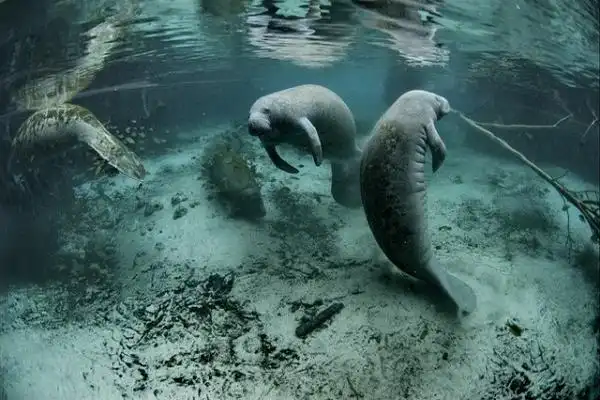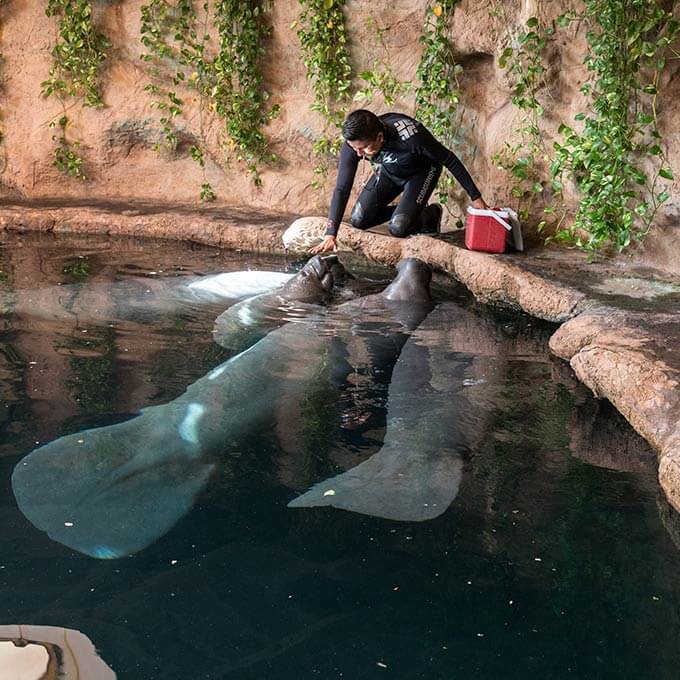Florida Manatees in Rehabilitation


Written and verified by the biologist Cesar Paul Gonzalez Gonzalez
The manatee is a marine mammal with a wide and tubiform body that measures between 3 and 5 meters in length (around 10 to 16 feet), weighing more than 300 kilograms (660 pounds). Despite its size, it is gentle and peaceful, as there aren’t many predators that can confront it in the wild. However, the pollution of water bodies and the destruction of their habitat have become a serious threat to them. Find out about the Florida manatees that are being rehabilitated in this article.
Several populations of this species are facing deplorable situations caused by human intervention, which has even led them to suffer from starvation. For this reason, some groups and foundations have started wildlife rescue projects to save their lives. An example of this is Florida, where 79 manatees have been placed in rehabilitation to stabilize their health. Read their story below.
A problem that began years ago
It’s common for bodies of water such as rivers, lakes or lagoons to be used by humans to pump waste water from neighboring cities or towns into. As can be imagined, this doesn’t only affect the appearance of the area, but also has an impact on the physicochemical content of the water and reduces its quality. Consequently, the health of all the animals and vegetation that depend on it is affected.
Several lakes and rivers in Florida suffer from this situation, such as the Banana River, the Indian River, and the Mosquito Lagoon, known collectively as Indian River Lagoon. In fact, the pollution of these areas indirectly caused the death of many manatees from 1982 to today. Even so, this has put agencies such as the Environmental Protection Agency on alert.
In the most current mortality records alone, it’s estimated that at least 500 manatees have died each year in Florida since 2015. Of these, just over 10% are due to natural causes, while the rest are related to human activities such as fishing, boat collisions, pollution, etc.

The death of more than 1100 manatees
Although several organizations began working almost immediately to protect the species, efforts and support didn’t reach their peak until after 2021. In this year, one of the most unfortunate events in relation to manatees occurred, as more than 1100 specimens were found dead floating in rivers and lagoons in Florida.
Contrary to what one might think, manatees aren’t so susceptible to the effects of pollutants in the water. In fact, they survive in environments with poor water quality such as the Indian River Lagoon. The problem is that the species depends on plants and seagrasses for food, and these don’t tolerate the pollution as well and can easily disappear from the environment.
The manatee is a herbivorous animal that needs to consume at least 10% of its body weight daily. Therefore, when vegetation is scarce due to pollution, it’s easy for specimens to suffer severe malnutrition leading to starvation and death.
This was the main reason for the sudden appearance of more than 1100 dead manatees floating adrift in Florida. They were just animals that died from exaggerated malnutrition because they didn’t have enough food in their habitat to survive.
Florida manatees in rehabilitation
After this distressing event, organizations focused on manatee conservation developed strategies to solve the lack of food for manatees. The first was the experimental feeding program with lettuce, which consisted of placing this vegetable at strategic points to supplement the manatees’ diet. The second consisted of rescuing and rehabilitating several specimens in the area.
Although the feeding program reduced the mortality of manatees in Florida, it wasn’t possible to cover all vulnerable specimens at the same time. This is the reason why different organizations formed The Manatee Rescue & Rehabilitation Partnership. This group focuses on rescuing, rehabilitating, and reintroducing several individuals in Florida to reduce the number of deaths.
As of the beginning of this year (2023) more than 79 manatees are being rehabilitated at places such as SeaWorld, zoos, and state parks. Here they’ll receive proper feeding and care to regain their weight and improve their health. After that, a suitable area will be chosen where they can be reintroduced and ensure they don’t go through the same thing.

Temporary strategies to relieve the real problem
Both the rehabilitation and the experimental feeding program are only temporary measures to reduce manatee deaths in Florida. This is because actions to correct water quality at the most affected sites aren’t immediately effective. In other words, the populations of the species will suffer food shortages for some time even if their habitat conditions improve.
Of course, local authorities are focused on repairing the damage to the rivers and lakes inhabited by the manatees. However, there’s still a long way to go to get them out of the danger they face.
In the meantime, remember to take care of your water consumption and avoid polluting rivers, lakes, seas, or lagoons. Although this doesn’t help them directly, you can be sure that it will benefit the natural surroundings around you.
The manatee is a marine mammal with a wide and tubiform body that measures between 3 and 5 meters in length (around 10 to 16 feet), weighing more than 300 kilograms (660 pounds). Despite its size, it is gentle and peaceful, as there aren’t many predators that can confront it in the wild. However, the pollution of water bodies and the destruction of their habitat have become a serious threat to them. Find out about the Florida manatees that are being rehabilitated in this article.
Several populations of this species are facing deplorable situations caused by human intervention, which has even led them to suffer from starvation. For this reason, some groups and foundations have started wildlife rescue projects to save their lives. An example of this is Florida, where 79 manatees have been placed in rehabilitation to stabilize their health. Read their story below.
A problem that began years ago
It’s common for bodies of water such as rivers, lakes or lagoons to be used by humans to pump waste water from neighboring cities or towns into. As can be imagined, this doesn’t only affect the appearance of the area, but also has an impact on the physicochemical content of the water and reduces its quality. Consequently, the health of all the animals and vegetation that depend on it is affected.
Several lakes and rivers in Florida suffer from this situation, such as the Banana River, the Indian River, and the Mosquito Lagoon, known collectively as Indian River Lagoon. In fact, the pollution of these areas indirectly caused the death of many manatees from 1982 to today. Even so, this has put agencies such as the Environmental Protection Agency on alert.
In the most current mortality records alone, it’s estimated that at least 500 manatees have died each year in Florida since 2015. Of these, just over 10% are due to natural causes, while the rest are related to human activities such as fishing, boat collisions, pollution, etc.

The death of more than 1100 manatees
Although several organizations began working almost immediately to protect the species, efforts and support didn’t reach their peak until after 2021. In this year, one of the most unfortunate events in relation to manatees occurred, as more than 1100 specimens were found dead floating in rivers and lagoons in Florida.
Contrary to what one might think, manatees aren’t so susceptible to the effects of pollutants in the water. In fact, they survive in environments with poor water quality such as the Indian River Lagoon. The problem is that the species depends on plants and seagrasses for food, and these don’t tolerate the pollution as well and can easily disappear from the environment.
The manatee is a herbivorous animal that needs to consume at least 10% of its body weight daily. Therefore, when vegetation is scarce due to pollution, it’s easy for specimens to suffer severe malnutrition leading to starvation and death.
This was the main reason for the sudden appearance of more than 1100 dead manatees floating adrift in Florida. They were just animals that died from exaggerated malnutrition because they didn’t have enough food in their habitat to survive.
Florida manatees in rehabilitation
After this distressing event, organizations focused on manatee conservation developed strategies to solve the lack of food for manatees. The first was the experimental feeding program with lettuce, which consisted of placing this vegetable at strategic points to supplement the manatees’ diet. The second consisted of rescuing and rehabilitating several specimens in the area.
Although the feeding program reduced the mortality of manatees in Florida, it wasn’t possible to cover all vulnerable specimens at the same time. This is the reason why different organizations formed The Manatee Rescue & Rehabilitation Partnership. This group focuses on rescuing, rehabilitating, and reintroducing several individuals in Florida to reduce the number of deaths.
As of the beginning of this year (2023) more than 79 manatees are being rehabilitated at places such as SeaWorld, zoos, and state parks. Here they’ll receive proper feeding and care to regain their weight and improve their health. After that, a suitable area will be chosen where they can be reintroduced and ensure they don’t go through the same thing.

Temporary strategies to relieve the real problem
Both the rehabilitation and the experimental feeding program are only temporary measures to reduce manatee deaths in Florida. This is because actions to correct water quality at the most affected sites aren’t immediately effective. In other words, the populations of the species will suffer food shortages for some time even if their habitat conditions improve.
Of course, local authorities are focused on repairing the damage to the rivers and lakes inhabited by the manatees. However, there’s still a long way to go to get them out of the danger they face.
In the meantime, remember to take care of your water consumption and avoid polluting rivers, lakes, seas, or lagoons. Although this doesn’t help them directly, you can be sure that it will benefit the natural surroundings around you.
All cited sources were thoroughly reviewed by our team to ensure their quality, reliability, currency, and validity. The bibliography of this article was considered reliable and of academic or scientific accuracy.
- Environmental Protection Agency. (2022). Statement from EPA’s Southeast Region Regarding the Manatee Deaths in Florida. Recuperado el 4 de febrero de 2023, disponible en: https://www.epa.gov/newsreleases/statement-epas-southeast-region-regarding-manatee-deaths-florida
- Save the Manatee Club. (2022). 2022 Manatee: Mortality Statistics. Recuperado el 4 de febrero de 2023, disponible en: https://www.savethemanatee.org/wp-content/uploads/2022/02/mortality_2021.pdf
- Save the Manatee Club. (2022). 2022 Manatee: Mortality Statistics. Recuperado el 4 de febrero de 2023, disponible en: https://www.savethemanatee.org/wp-content/uploads/2022/02/mortality_2021.pdf
- Save the Manatee Club. (2020). 2022 Manatee: Mortality Statistics. Recuperado el 4 de febrero de 2023, disponible en: https://www.savethemanatee.org/wp-content/uploads/2021/04/Mortality_Rescue_2020_.pdf
- Florida Fish and Wildlife Conservation Commission. (2023). Manatee Rescue & Rehabilitation Partnership. Recuperado el 4 de febrero de 2023, disponible en: https://myfwc.com/research/manatee/rescue-mortality-response/rescue/mrp/
- Fish & Wildlife Foundation of Florida. (). MARINE MAMMAL FUND. Recuperado el 4 de febrero de 2023, disponible en: https://wildlifeflorida.org/mmf/
- Runge, M. C., Lantimm, C. A., Martin, J., & Fonnesbeck, C. J. (2015). Status and threats analysis for the Florida manatee (Trichechus manatus latirostris), 2012. US Department of the Interior, Geological Survey.
This text is provided for informational purposes only and does not replace consultation with a professional. If in doubt, consult your specialist.








